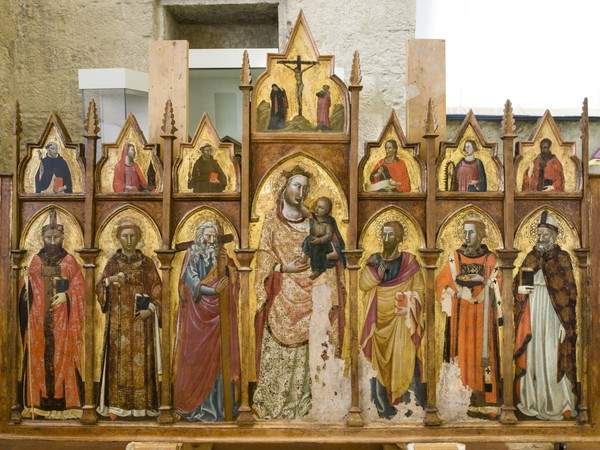Gubbio showcases rediscovered treasures, works of art from Giotto's time all restored
The major exhibition Gubbio in Giotto’s time( newshere ) closed with more than 26,000 visitors. This was informed by the organization of the exhibition, which explains in a note: “Interested public and specialists were able to appreciate the proposed narrative, deliberately decentralized on three locations in Gubbio, chosen not by chance, but because they are representative of the centers of medieval power, the oldest civic palaces and the bishop’s seat, influential and decisive spheres on the political, civil, spiritual and artistic life of Gubbio at the time of Giotto.” Precisely thanks to the collaboration between the Municipality of Gubbio, the Eugubina Diocese, the Polo Museale dell ’Umbria and under the supervision of the Superintendence for Archaeology, Fine Arts and Landscape of Umbria, the communiqué continues, “the event has returned to the community a series of restored works that on balance represent the most substantial nucleus of the entire city museum heritage from the medieval period. It should be added, moreover, that previous interventions have been verified and fine-tuned with even minimal adjustments, but all functional to the legibility of the work and its ability to refer data and elements in a context of comparisons and comparisons such as was, precisely, Gubbio in Giotto’s time.”
The restoration campaign is the basis of the new exhibition Found Treasures. Restorations for Gubbio in Giotto’s time, at the Sala dell’Arengo in Palazzo dei Consoli from November 15, 2018 to May 1, 2019 precisely dedicated to restorations and recoveries and thus to the possible comparisons between works and masters, between materials and execution techniques, between forms and functions of the artistic product in a path that unravels between the 13th and 14th centuries, in the golden age of Gubbio and its vast countryside.
Many of the recently restored works will be on display: such as the two large painted crosses from the Gubbio Civic Museum, works by the Master of the Cross of Gubbio, the Expressionist Master of Santa Chiara, Pietro Lorenzetti, the so-called “Guiducci Palmerucci” and Mello da Gubbio.
What is preserved and available, in fact, makes it possible to reason on many topics, but above all it allows us to reread the evolution of Gubbio art between the thirteenth and fourteenth centuries in relation to the great artistic centers of the time. First of all with Assisi, a center from which impulses of figurative culture were propagated, the intensity of which we record, before elsewhere, precisely in Gubbio. In the land of the miniaturist Oderisi, “the honor of Agobbio” whom Dante encounters and celebrates in Purgatory, the Assisi inventions of Cimabue, the Roman painters and Giotto are immediately received and provoke reactions, solicit updates, encourage interpretations and even attempts at resistance.
And when a new impetus departs from Assisi, following the arrival of the avant-garde, the Sienese Pietro Lorenzetti and Simone Martini, Gubbio painting immediately reorients itself, proving once again that it can deal with the new. A long dialogue then opens with Siena, the same one that determines a new artistic season, rich, complex, prolific, which will have repercussions not only in the city within the walls, but throughout the boundless municipal territory and beyond, wherever the works of Gubbio artists are sent. It is the season of the Palazzo dei Consoli, the Palazzo del Podestà, Piazza Grande, the affirmation of popular government, the worship of patron saints, economic, urban, territorial development.
The exhibition Rediscovered Treasures speaks of this history, as recent restorations have thrown new light on the works, their qualities, peculiarities and characteristics, data and knowledge that allow us to stitch together the shreds of a fabric that has been severely torn, but is still able to revive, excite, teach.
Hours: Nov. 15 to March 31: Monday to Friday 10 a.m.-1 p.m. and 2:30-5:30 p.m.; weekends 10 a.m.-6 p.m. April 1 to May 1: Monday to Friday 10 a.m. to 1 p.m. and 3 p.m. to 6 p.m.; weekends 10 a.m. to 6 p.m. (ticket office closes 30 minutes before closing time); Jan. 1 3 p.m. to 6 p.m. Closed December 25.
Ticket price: full 10 €, reduced 8.50 € for groups (min. 15 people), residents, holders of special agreements, over 65 years, 1 adult plus child up to 12 years, Special reduced 5 € schools and children 7 to 25 years. Free for children under 6 years, accompanying teachers, disabled people + accompanying person, accredited journalists, licensed tour guides. For all information you can call +39 075 9274298 or email museo@gubbiocm.it.
Pictured: Expressionist Master of Santa Chiara (Palmerino di Guido?) and collaborator (attributed), Polyptych with Madonna and Child and Saints after restoration, Gubbio, Museo Civico
 |
| Gubbio showcases rediscovered treasures, works of art from Giotto's time all restored |
Warning: the translation into English of the original Italian article was created using automatic tools. We undertake to review all articles, but we do not guarantee the total absence of inaccuracies in the translation due to the program. You can find the original by clicking on the ITA button. If you find any mistake,please contact us.



























